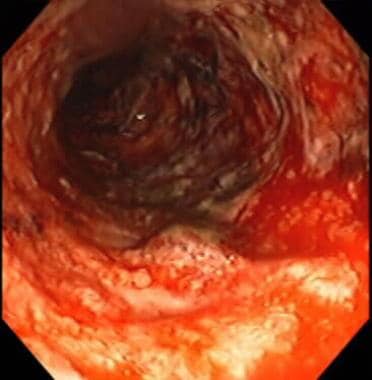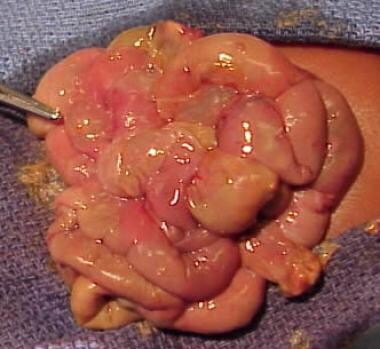Practice Essentials
The term colitis refers to inflammation of the colon. It may be associated with enteritis (inflammation of the small intestine), proctitis (inflammation of the rectum), or both. Inflammatory bowel disease (IBD) is a generic term used to describe 3 idiopathic disorders that are associated with gastrointestinal (GI) inflammation:
-
Indeterminate colitis
IBD affects approximately 1.5 million Americans and worldwide, the incidence seems to be increasing. A systematic review of all population-based studies describing the incidence and/or prevalence of IBD demonstrated that the incidence of IBD (both CD and UC) is increasing in many regions of the world. However, the incidence and prevalence of IBD remains highest in industrialized nations. Less data were available from developing countries, but the evidence suggests that IBD is emerging as a global disease. [1]
In addition, numerous different conditions can cause colitis, each of which has its own pathophysiology. These include the following:
-
Allergic colitis
-
Pseudomembranous colitis
-
Infectious colitis (bacterial, parasitic, or viral)
-
Ischemic colitis
-
Colitis secondary to immune deficiency disorders
Pathophysiology
Necrotizing enterocolitis
NEC is a common cause of colitis in newborns (see the image below). Very small and ill preterm infants are particularly susceptible to NEC. NEC is multifactorial, but prematurity and the presence of bacteria in the GI tract are significant risk factors associated with NEC.
NEC appears to involve an inappropriate inflammatory response in an immature intestine. The final common pathway seems to include the endogenous production of inflammatory mediators, such as endotoxin lipopolysaccharide, platelet-activating factor, tumor necrosis factor, and other cytokines, decreased epidermal growth factor, and progressive mucosal damage by free radical production. [2]
Hypoxic ischemia and aggressive enteral feedings are also associated with the pathogenesis of NEC. Varying degrees of mucosal or transmural necrosis of the intestine and colon are recognized. The distal ileum and proximal colon are most frequently involved; in severe cases, gangrene may involve the whole bowel from the rectum to the stomach.
NEC presents with the gas accumulation in the submucosa of the bowel wall and progresses to necrosis leading to perforation of the bowel, peritonitis, and sepsis. Histological changes in NEC include mucosal edema, hemorrhage, coagulation necrosis, and mucosal ulceration.
Allergic colitis
In children aged 2 weeks to 1 year, the most common form of colitis is allergic colitis, which results from hypersensitivity, commonly to cow’s milk and soy milk. [3] So-called breast milk allergy is a status of food allergy induced in breastfed babies by heterologous proteins (typically cow’s milk proteins) ingested by their mothers and appearing in their breast milk. Immunologic responses may range from classic allergic mast cell activation to immune complex formation.
Pseudomembranous colitis
Pseudomembranous colitis is a form of inflammatory colitis characterized by the pathologic presence of pseudomembranes consisting of mucin, fibrin, necrotic cells, and polymorphonuclear leukocytes (PMNs).
This form of colitis is pathognomonic of infection by toxin-producing Clostridium difficile and develops as a result of altered normal microflora (usually by antibiotic therapy) that favors overgrowth and colonization of the intestine by Clostridium difficile and production of its toxins. Although every antibiotic has been reported to be associated with pseudomembranous colitis, cephalosporin and beta-lactam antibiotics are most frequently implicated in children. Cases in children with underlying comorbid conditions, IBD in particular, are also common. [4]
Inflammatory bowel disease
The etiology of IBD is poorly understood. Genetic and environmental influences are involved in the pathogenesis. IBD may present either as UC or as CD. Indeterminate colitis is a term to describe a chronic idiopathic colitis that cannot be separated based on conventional diagnostic modalities to either Crohn colitis or ulcerative colitis.
A study by Starr et al sought to identify proteins that enable differentiation between CD and UC in children with new onset IBD. The study found two panels of candidate biomarkers for the diagnosis of IBD and the differentiation of IBD subtypes to guide appropriate therapeutic interventions in pediatric patients. [5]
 Inflammatory bowel disease. Severe colitis noted during colonoscopy. The mucosa is grossly denuded, with active bleeding noted. This patient had her colon resected very shortly after this view was obtained.
Inflammatory bowel disease. Severe colitis noted during colonoscopy. The mucosa is grossly denuded, with active bleeding noted. This patient had her colon resected very shortly after this view was obtained.
UC is characterized by inflammation and ulceration confined to colonic mucosa, whereas CD is manifested by transmural inflammation and granulomas that may affect any segment of the GI tract, including the colon. UC invariably involves the rectum and extends proximally without skipping segments. In contrast, CD has discontinuous patchy involvement of the GI tract, with the ileum being the most commonly affected segment.
Growth failure results from malabsorption and loss of proteins from inflammation and damage to the mucosa; it is 3 times more likely to occur in children with CD than in children with UC.
The diarrhea also results from mucosal damage, bile acid malabsorption, bacterial overgrowth, and protein exudation from mucosa. Extraintestinal manifestations, which are slightly more common in CD than in UC, result from bacterial products and inflammatory mediators (eg, cytokines, prostaglandins, and reactive oxygen metabolites) entering and subsequently being deposited in various tissues and organs, such as the eyes (uveitis), skin (erythema nodosum), liver (cholangitis, hepatitis), and joints (arthritis).
Infectious colitis
Infectious colitis is the most common cause of pediatric colitis, particularly beyond the first year of life. It can be caused by bacterial, viral, and parasitic pathogens.
Bacterial colitis
The most common bacterial causes of colitis in children are Escherichia coli (including both enterohemorrhagic E coli [EHEC] and enteroinvasive E coli [EIEC]) and species of Shigella, Salmonella, Campylobacter, and Yersinia.
Salmonella infections can be divided into those that cause typhoid (enteric) fever and those that do not. In more industrialized countries, infection with nontyphoid Salmonella accounts for a significant proportion of cases of food poisoning. Salmonella infections are typically spread via the fecal-oral route; outbreaks are commonly associated with contaminated eggs, dairy products, and meats. Gastric acid is usually lethal to the organism, but susceptibility to infection is increased with decreased GI motility, rapid emptying of the stomach after gastrectomy, a large quantity of ingested bacteria, malnutrition, antibiotic use, and achlorhydria. Salmonellae can penetrate the epithelial layer to the level of the lamina propria and evoke a leukocyte response. They cause diarrhea by producing several toxins and prostaglandins, which stimulate the active secretion of fluids and electrolytes.
Shigella species attach to binding sites on the surface of the intestinal mucosal cells. The organism penetrates and proliferates in the cell, which leads to cell destruction, produces mucosal ulcerations, and causes bleeding. Shigellae also elaborate the exotoxins that produce diarrhea.
E coli may produce diarrhea in several different ways, depending on their specific pathologic characteristics. Pathologic strains of E coli have been classified as follows:
-
Enteropathogenic
-
Enterotoxic
-
Enteroinvasive
-
Enteroaggregative
-
Enteroadherent
-
Enterohemorrhagic
EHEC, including O157:H7 and O26:H11, causes hemorrhagic colitis and systemic complications (eg, hemolytic uremic syndrome [HUS]). The risk of developing HUS after infection with E coli O157 is estimated to be 10-15% in children. In typical infectious colitis, the lamina propria of the large intestine is infiltrated by PMNs. EIEC, on the other hand, exhibits almost exactly the same pathogenetic mechanisms as Shigella.
Parasitic colitis
Entamoeba histolytica is the most common cause of parasitic colitis in the world. Transmission takes place through ingestion of trophozoites (usually from water contamination) and person-to-person transmission (typically because of poor sanitation). Balantidium coli is a large ciliated protozoan that also causes colitis; balantidiasis manifests in much the same way as amebiasis.
Viral colitis
Colitis caused by cytomegalovirus (CMV) infection is a rare form that typically is found in immunocompromised patients (eg, organ recipients who are receiving immunosuppressive treatment). It results in deep round ulcerations that have a tendency to bleed easily and profusely. Adenovirus infection can also cause a severe colitis in immunocompromised patients, especially those with AIDS, although patients with solid organ and bone marrow transplants are also at risk.
Ischemic colitis
Ischemic colitis is a form of vasculitis that results from inflammation and ischemia of colonic mucosa, which causes rectal bleeding and abdominal pain. This form of colitis is common in Henoch-Schönlein purpura (HSP), which is considered one of the collagen-vascular diseases.
Congenital immune deficiency
Several primary immunodeficiency syndromes, including common variable immunodeficiency, chronic granulomatous disease, Wiskott-Aldrich syndrome, and IPEX (immunodysregulation, polyendocrinopathy, enteropathy, X-linked) syndrome, have all been associated with an IBD-like clinical and histopathological presentation. Patients may present with clinical signs and symptoms indistinguishable from patients with IBD, including chronic abdominal pain, diarrhea, and colitis-like symptoms. Indeed, extraintestinal manifestations such as failure to thrive, developmental delay and perianal diseases are common presenting complaints.
Etiology
Inflammation of the colon can be caused by infection, hypersensitivity to various allergens, ischemia, vasculitis, or several drugs.
The cause of colitis in IBD is unknown, but the available evidence suggests that IBD involves an abnormal immune response, likely to environmental factors, in a genetically susceptible host. The observation that IBD is occurs more frequently in industrialized, as opposed to developing, countries has led to the “hygiene hypothesis.” The hygiene hypothesis suggests that in parts of the world where humans are exposed to fewer microbes, the intestinal immune system might not be as prepared to respond to antigens. Like bacteria, diet is thought to be a potential environmental factor as the bacteria and diet are two of the most common environmental factors to which the gut is exposed.
Evidence also suggests a genetic predisposition to IBD, including ethnic differences, family aggregation, concordance rates in twins, chromosomal linkage, and genetic syndromes associated with IBD. However, the lack of total concordance of disease among monozygotic twins, along with other differences, supports a role for environmental cofactors in the development of IBD.
In the United States, bacterial and viral infections are very common causes of colitis, whereas in developing countries, parasitic infections are very common causes.
Epidemiology
United States statistics
Approximately 25% of cases of IBD occur during childhood and adolescence. [6] The risk of IBD in family members of an affected individual is 5-30%; children born to a parent with IBD develop IBD approximately 6-9% of the time, and, in the rare instance that both parents have IBD, studies estimate that their children have a 33% chance of developing IBD by age 28 years. [7]
The prevalence of CD and UC in the United States is estimated to be 400 per 100,000 persons. In the pediatric population, the prevalence of IBD overall rose by 133% over a 9-year period (from 33.0/100,000 in 2007 to 77.0/100,000 in 2016). Among children, CD was twice as prevalent as UC (45.9 vs 21.6). Boys are affected more than girls for all forms of IBD. [8]
NEC affects 1-5% of patients admitted to neonatal intensive care units (ICUs). NEC may occur in 2-5% of infants with birth weights lower than 1500 g and up to 10% of infants with birth weights lower than 1000 g. In the United States, the prevalence of amebiasis in high-risk groups is reported to be 1-4%.
International statistics
IBD is most prevalent in northern Europe and North America and is less common in the Asia-Pacific region, with the exception of Australia. [9] Dramatic increases in incidence of IBD have occurred in many parts of the world, typically occurring in more industrialized countries. [1] A north-to-south gradient also appears to be present, with higher incidences of both UC and CD in northern locations. The prevalence of amebic infections worldwide varies from 5-81%, with the highest frequencies occurring in tropical climates.
Age-, sex-, and race-related demographics
NEC is a disease of newborns, with low- and very low–birth-weight preterm infants being particularly susceptible. Allergic colitis is the most common form of colitis during the first year of life. IBD is generally diagnosed in children aged 5-16 years. It has a bimodal distribution, with an early onset at age 15-25 years and a second smaller peak at age 50-80 years. HSP occurs in school-aged children and young adults. It is common in males.
The prevalence of IBD is increased among Jewish people of European Ashkenazi descent. A positive family history is the most consistent risk factor for children with IBD. HSP is common in white people. Food-allergic colitis is believed to be present in approximately 2-3% of all infants. [10]
Prognosis
Diarrheal diseases are among the leading causes of morbidity and mortality in children worldwide, causing 1 billion episodes of illness and 3-5 million deaths annually. In the United States, 20-35 million episodes of diarrhea occur each year in the 16.5 million children who are younger than 5 years, resulting in 300-400 deaths.
Medical treatment fails in 20% of patients who have NEC with pneumatosis intestinalis at diagnosis, resulting in a 9-25% mortality. The mortality of NEC is higher than 50% in infants with birth weights lower than 1000 g. A meta-analysis by Jones and Hall showed that NEC accounts for 1 in 10 neonatal deaths, and up to 61% of survivors have significant neurodevelopmental delays. [11]
About 70% children with UC enter remission within 3 months of initial therapy, and 50% remain in remission over the next year. Colectomy within 5 years is required in as many as 26% of children who present with severe disease compared with less than 10% of those who present with mild disease. Approximately 70% of children with CD require surgery within 10-20 years after the diagnosis.
A meta-analysis by Elmahdi et al found a 2.4-fold increase in the relative rate of cancer among patients with pediatric-onset IBD compared with the general pediatric population. The highest relative rates were for gastrointestinal cancers, including a 55-fold increased risk for liver cancer, a 20-fold increased risk for colorectal cancer, and a 16-fold increased risk for small bowel cancer. [12]
The risk factors for developing adenocarcinoma in UC are the duration and extent of disease. After the first decade of disease, the risk of development of colon cancer increases rapidly; thus, surveillance colonoscopy should be performed annually or biannually after 8-10 years of colonic disease. Colectomy should be performed if there is finding of high-grade dysplasia. [13]
The course of UC is marked by remissions and exacerbations. Most patients respond initially to medical treatment, and many children with mild manifestations stay in remission on prophylactic therapy with 5-aminosalicylic acid (5-ASA). Despite complications, most children with CD lead active lives, despite intermittent symptom flare-ups.
Patient Education
Psychosocial support and education for the family are important in achieving long-term goals in the treatment of IBD. Counseling and peer support for the adolescent who has growth and pubertal delays are helpful.
-
Necrotizing enterocolitis totalis.
-
Inflammatory bowel disease. Severe colitis noted during colonoscopy. The mucosa is grossly denuded, with active bleeding noted. This patient had her colon resected very shortly after this view was obtained.











